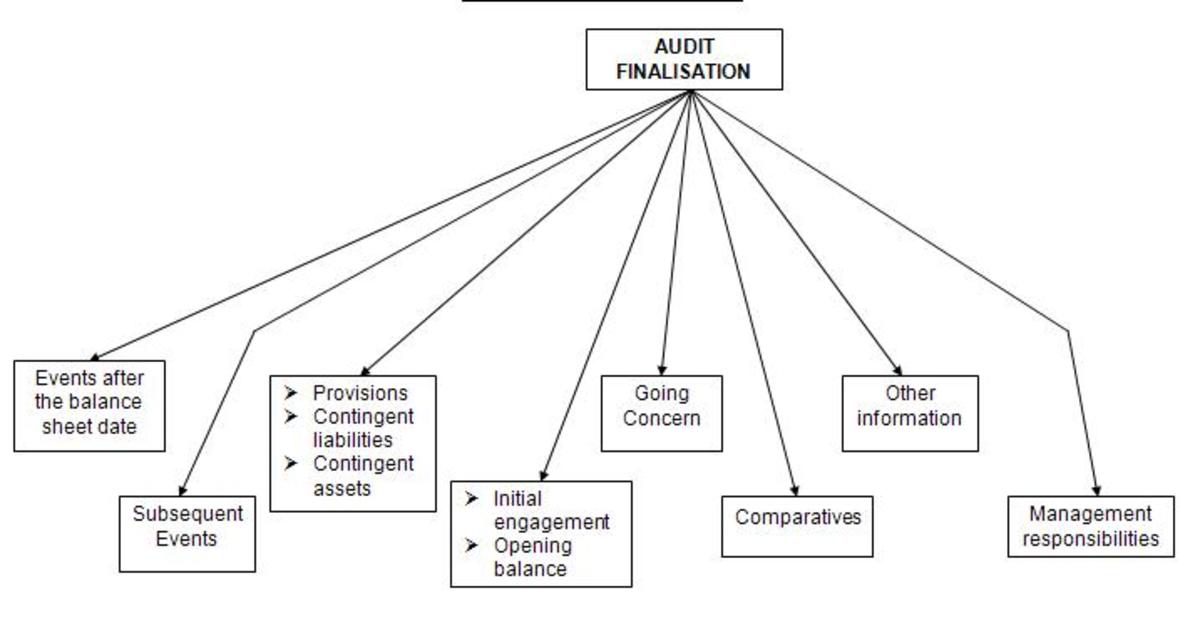Audit planning - Steps and Strategy
Sources of knowledge
Following are important sources which provide background knowledg
External client:
- Directors/senior personal
- Internal audit financial
- Visit to premises
- Minutes of meetings
- Documents sent to shareholders and authorities
- Financial budgets
- Management reports
- Charts of accounts
- Job organization ad descriptions
Auditor:
- Predecessor auditors
- Legal advisor
- Industry regulations
- Chamber of commerce
- Govt. data
- Customers
- Bankers
- Suppliers
- Competitors
- Trade journals
- Financial press
Use of knowledge
- To develop overall plan and audit programme
- To assess component of risk
- To determine materiality levels
- To evaluate audit evidence
- To identify related parties and transactions
- To recognize conflicting and unusual circumstances
- To appraise appropriateness and effectiveness to accounting policies
- To provide better service to client
Nature of information
- General economic factors
- Recession / growth
- Interest rates
- Inflation
- Fiscal policy
- Monitory policies
- Foreign currency
- Devaluation / evaluation
- The industry
- Market
- Technology
- Key ratios
- Specific accounting ratios
- Environmental requirements
Audit Planning Factors
General economic factors
- Recession / growth
- Interest rates
- Inflation
- Fiscal policy
- Monitory policies
- Foreign currency
- Devaluation / evaluation
Management and ownership
- Corporate structure
- Owners and related parties
- Capital structure
- Organization structure
- Strategic plan
- Operating management
- Audit committee
Business
- Nature of business
- Locations
- Products / services / markets
- Suppliers
- Investors
- Information systems
- Debt structure
- Financial performance
Key ratios
- Trends
- Accounting policies
- Leasing commitments
- Off balance sheet finance
Reporting environment
- Legislation
- Taxation
- Securities
- Users of financial statements
Audit DOCUMENTATION
Definition:
The material (working papers) prepared by and for (or obtained and retained by) the auditor relating to the conduct of the audit.
In the form of data stored on paper, film, electronic or other media matters, which are important in providing evidence, must be documented.
To support the audit opinion
To demonstrate that the audit was performed in accordance with ISAs.
Audit Working Papers
assist in the planning and performance of the audit (e.g. in providing information)
facilitate the supervision and review of audit work (e.g. in giving instructors to assistants)
Matters To Consider
Nature of the engagement e.g.
- Private or public sector; and
- Other services undertaken (e.g. taxation, systems advice)
From the auditor’s report (e.g. standardized, “short-form” report in which there is “modified” opinion)
Nature and complexity of the organization and its accounting and internal control systems (e.g. the extent of computerization)
Specific audit methodology (e.g. a risk-based approach) and technology (e.g. computer-assisted audit techniques) used in the course of the audit
Standardization
Extent of schedules, analyses and other documentation prepared by the entity
Needs of direction, supervision and review of tasks assigned to assistants.
STANDARDIZATION
It is common practice for audit firms to use standard pre-printed documentation on audit engagement. For example:
Audit completion, disclosure and other checklists
Internal control questionnaires
Audit programs
Specimen letters – e.g. management representation letters
Documentation Techniques
Narrative notes
Flowcharts
Questionnaires
Checklist
- Narrative notes – written descriptions require little formal training and are best suited to small, simple systems descriptions or to explain peripheral aspects of larger systems not dealt with by other techniques (e.g. the issue of credit notes)
- Flowcharts – visual descriptions highlight controls and are easy to understand by a trained use. However, different audit firms and their clients use different types (e.g. documentation flowcharts, information flowcharts and overview flowcharts).
- questionnaires – internal control questionnaires (ICQs) are designed to indicate which parts of a system are strong or weak and so make a preliminary assessment o the extent to which the auditor seeks to place reliance (if any) on internal controls.
Factors To Consider
The form and extent of this documentation is influenced by such factors as:
Size and complexity of entity
Nature of accounting and internal control systems (e.g. manual or electronic)
Auditors intended reliance on internal controls
Whether prepared by client (e.g. internal audit department) or external auditor
Ease of preparation and / or updating
CONFIDENTIA LITY, SAFE CUSTODY, RETENTATION AND OWNERSHIP
Auditors should maintain the confidentiality and safe custody of working papers.
Confidentiality And Safe Custody
Practical procedures include locked fireproof cabinets or rooms and the use of physical keys and logical passwords.
Electronic documentation may be particularly susceptible to corruption or loss and should be backed up.
Considerations not in the ISA
Legal requirements e.g. accounting records must be maintained for 3 years for private companies and 6 years for other companies in the UK.
General position in law governing the period of time in which actions may be brought in a court of law e.g. 6 years for actions based on contract in the UK.
Requirements for compiling tax returns e.g. assessments may be made 6 years after the period to which they relate.
Likelihood of seeking quotation on a recognized stock exchange – previous 6 years are required to be reported on in UK.
Minimum Period
Audit working papers – 7 years
Recommended by ACCA
Tax files – 7 years and then returned to client (or former client)
Ownership
Working papers are the property of the auditor and clients have no rights to demand access
General Principles
Portions of or extracts from working papers may be made available to the entity at the discretion of the auditor
All documents relating to clients are confidential
A client may require auditor to disclose documents, which belong to the client (only) to a third party.
Standardization Of Documents
Advantages
Disadvantages
Preparation and review is more efficient when audit files and sections and documents within them are presented in systematic manner
A “mechanical” approach may lead to a lack of appreciation of test objectives and the implications of errors and deviations founds
Helps to familiarize junior staff with standard procedure (e.g. attending physical inventory counting and requesting direct confirmations from customers).
Adopting a “standard approach” may stifle initiative and discourage the exercise of professional judgement
Similarly, it facilitates
Standard programs may result in a “bare minimum” attitude.
It provides a means of quality control by requiring a consistent approach to all audits and ensuring that essential procedures not overlooked.
It may be inappropriate to follow set procedures for a particular client (e.g. one with subscription income rather that sales revenue)
CONTENTS FO WORKING PAPERS
Permanent Audit File
Information concerning legal structure of entity (e.g. memorandum and articles of association)
Other documents of continuing importance
- Terms of engagement
- Minutes of important meetings
- Debenture deeds
- Mortgage and charges
- Title deeds and lease agreements
- Agreements and labor contracts
- Profit share and bonus agreements
- Royal agreements
Descriptions of nature and history of client’s business, locations and products
A list of client’s investments (if any)
Organization charts, with extra details for finance department
Main accounting records, showing where kept and of what type (e.g. handwritten, computerized)
Copies of previous financial statements and auditor’s reports thereon
Previous reports to management (detailing weaknesses found in the accounting system)
Client’s other professional adviser
Client’s insurance covers details
Significant ratios and trends
Accounting systems descriptions in flow chart and narrative from
Internal controls evaluation data: questionnaires and checklists
Principals accounting policies.
Current Audit Files
Financial statements being audited (evidenced as having been agreed to accounting records and cross-referenced to supporting schedules)
Overall audit plan (including risk assessments and planning materiality) and audit program
Schedule for each balance sheet item (including comparatives), cross-referenced to documents arising from external verification (e.g. of existence and valuation). For example, confirmation of accounts receivable and attendance at physical inventory counting).
Copies of communications with other auditors, experts, and other third parties
Schedule supporting each significant item in the income statement
Checklist of compliance with statutory and IAS disclosure provision
A record of queries raised during the audit and their clearance, with notes for next year
Schedule of queries not cleared for the manager / partner reviewing the audit
Extracts of minutes of meetings of directors and shareholders (cross-referenced where relevant)
Report of management of material weaknesses in internal controls including client response
Letter of representation received from management
Job administration data
- Partner and staff employed
- Dates audit areas completed time summaries
- Time summaries
- Performance monitored against budget
Working papers of results of tests, evaluation of systems, control weakness and action taken
Schedule of results of audit tests on transactions and balances and conclusions reached (indexed and cross-referred to demonstrate sufficient and evidence)
Completed audit program
Accounts completion checklist.
Risk Assessment
Entity risk assessment is different from auditor’s risk assessment
Entity
The purpose of entity risk assessment is to identify, analysis (priorities) and manage risks that effect entity objectives
Auditor
The purpose of auditor’s risk assessment is to evaluate the likelihood that material misstatement could occur in financial statements
Inherent Risk Assessment
Inherent risk is risk that items will be misstated due to characteristics of those items such as that they are estimates or complex accounts.
Auditor must use their professional judgement to assess inherent risk at two level
- at the financial statements level
- at the account balance and class of transaction level
At Financial Statement Level
In developing the overall audit plan the auditor should assess inherent risk at financial statement level. The relevant factors to be considered are
Factors Affecting Client as Whole
FACTORS
EXAMPLES
Directors attitude to risk
Domination of decisions by one person
Industry factors
Declining industry causing going concern problems, rapid changes in consumer demand
Management experience and knowledge
High management turnover, poor reputation of management
Unusual pressure on management
Tight reporting deadlines, undue emphasis on meeting earning projection
Nature of business
High sensitivity to economic factors (inflation, interest rate etc)
At Account Balance And Class Of Transaction Level
In developing audit programme auditor should assess inherent risk at account balance and class of transaction level.
Factors Affecting Individual Accounts Balance Or Transaction
FACTORS
EXAMPLES
Related party transactions
Transactions involving director’s interest
Unusual transaction
Year end transactions or transaction involving high accounts
Accounts prone to misstatement
Provisions and prior period
Complex items
Expert valuations
Competence personnel
Unqualified and untrained staff
Assets desirability
Movable assets such as cash, laptops.
Control Risk Assessment
Control risk is the risk of material misstatement not being prevented or detected by internal controls control risk should be assessed in terms of financial statement assertions.
Presentation and disclosure
Existence or occurrence
Rights and obligations
Completeness
Valuation
Detection Risk
Detection risk is risk that material misstatements not being detected by auditor’s substantive procedures.
The auditor’s inherent and controls risk assessment influences the nature timing and extent of substantive procedures required to reduce detection risk and thereby audit risk. In this regard auditor would consider modification in;
Nature - Change from less effective to more effective t4ests (i.e. direct third party confirmation rather then internal evidence)
Timing - Less reliance on interim testing
Extent – Larger sample size
Inter Relationship Of Components Of Audit Risk
There is an inverse relationship between combined levels of inherent and control risk and detection risk, following table shows how acceptable level of detection risk may vary based on combined assessment of inherent and control risk.
Control Risk Assessment
Inherent risk assessment
Analytical Procedures
Consist of analysis of significant ratios and trends including the resulting investigations of fluctuation and relationships that are inconsistent with often relevant information or which deviate from predictable amounts
Purpose
Analytical procedures used for 3 purposes
1. Planning nature timing and extent of other auditing procedures
2. substantive test about particular assertions
3. overall view in the finance stage of audit
Nature
The ISA states that analytical procedure include consideration of;
a) Comparison with prior period comparable financial information and anticipated results such and budgets forecasts industry information
b) Relation between
- Elements of financial information such as gross profit to sales
- Financial and relevant non-financial information such as payroll to no. of employees
Stage
Auditor should apply analytical procedures at
Planning stage
Substantive tests stage
Overall review stages
Planning Purpose
To assist auditor to
Understand the business and events since last audit.
Identify areas of potential risk
Determine timing nature and extent of other audit procedures.
Possible sources of information about client include
Interim financial statements
Management accounts
Tax returns (sales, income)
Board minutes
Discussions with client at year end
Substantive Test Purpose
To assist auditor to
Obtain corroborative evidence
Test details of transactions
Detect material misstatements in financial statements
Reduce detections risk for financial statements assertions.
Factors
When intending to perform analytical procedures as substantive procedures auditor should consider following factors
FACTORS
EXAMPLE
Comparability
Financial information is comparable when accounting policies are consistent in comparable periods
Objective
Normally to obtain corroborative evidence
Desegregation of information
Breakup of administrative expenses appearing in P & L accounts to get more accurate picture for investigations of unusual fluctuations.
Source of information
Independent sources are more reliable than internal sources
Availability of information
Auditor should have unrestricted access to all relevant information
Relevance of information
Marketing expenses and sales, wages and laborers
Reliability of information
Whether budgets are prepared with due care and skill and are realistic
Knowledge gained during previous audit
Adjustment in prior periods
Significant changes in structure culture and resources.
Extent Of Reliances
The extent of reliance that the auditor place on the results of analytical procedures depends on following factors.
FACTORS
EXAMPLE
Materiality of items
When inventory balances are material does not rely only on analytical procedures
Assessment of inherent and control risk
If it is high, place more reliance on test of details of transactions than on analytical procedures
Other audit procedures
To confirm accounts receivable review subsequent cash receipts
Consistency and accuracy of results
Auditor expect greater consistency in comparing margins than from one period to another than in comparing discretionary expenses such as research and development.
Overall Review Purpose
Is to assist auditor to
Assess the conclusions reached
Highlight areas, which require further investigations
Ensure that financial statements as a whole are consistent with auditors knowledge
Consider in formations necessary for assisting in the planning of subsequent audit
Investigations
When analytical procedures identify
Significant fluctuations
Relationship that are inconsistent with often
Deviation from predicted results.
Auditor should investigate and obtain adequate explanations and appropriate corroborative evidence by
Inquiries of management
Corroborations of management response by comparing them with auditor’s knowledge and other evidence obtained during audit. If explanations can not be given by management or if they are insufficient the auditor must determine which further audit procedures to undertake such as modification of report.
Practical Techniques
Analytical techniques may be
Ratio analysis
Examination of accounts
Trend analysis
Bar graph, Pi chart
Time service analysis
Visual presentations
Reasonableness test e.g. Depreciation = (cost + additions – disposal) x ratio of depreciation
Working Papers
Working papers must contain the completed result of analytical procedures.
They should include:
Summary of comparisons
Summary of significant figures
Details of significant fluctuations
Details of results of investigations
Audit conclusions reached
Information considered necessary for planning subsequent audit
Important Ratio
GP margins
In total
By product
By segments
By months/quantity (if possible)
Expense ratio to sales
Receivable ratios and collection periods
Inventory turnover
Current ratio
Quick ratio
Gearing ratio
Return on capital
Related Items
Payable and purchases
Goods and costs of sales
Assets and depreciation and amortizations
Investment and investment income
Receivable and bad debts
Area Of Investigation
Significant changes during the period
Structure
Culture
Resources








